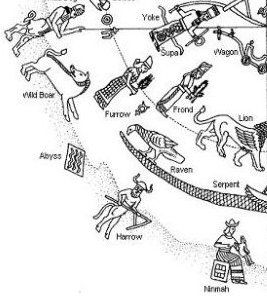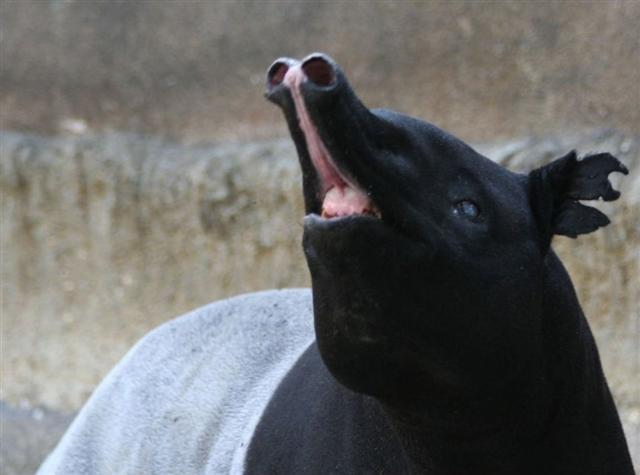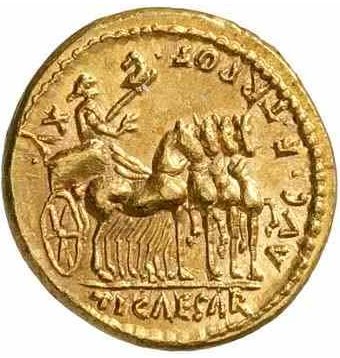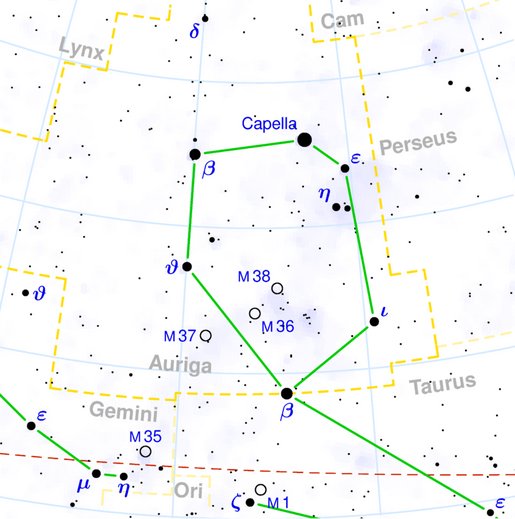35. There was a Cave beyond the Tree which could have corresponded to that of Polyphemus. In the Rain God series he was coming down through the air in order to walk with his feet on the still moist ground - to plant seeds in his footprints. ... Wilkinson begins his description of the Egyptian Ram pictures by pointing out that these sheep were lead by a wether when they were used for pushing down seeds into the mud after the yearly inundation of the Nile ...
And at the other side of the Tree he was covered by earth (hilled up like a great sweet potato). His left hand instrument in the following panel seems to be a water-lily - undulating like a hose (a planted seed needs fresh water). In his right hand he wields a flint axe. He is an ambidexter.
6 of the men of Odysseus were eaten and 6 remained: this could have been a way to tell of how half the year was in the past. Furthermore, Odysseus used trickery - he said he was No-man. He lied (or he was a woman in disguise). Once upon a time Raven, the trickster, must have been at this place - also with a crooked lie in his beak:
Φ
... the bird [Raven], being sent with a cup for water, loitered at a fig-tree till the fruit became ripe, and then returned to the god with a water-snake in his claws and a lie in his mouth, alleging the snake to have been the cause of the delay. In punishment he was forever fixed in the sky with the Cup and the Snake; and, we may infer, doomed to everlasting thirst by the guardianship of the Hydra over the Cup and its contents. From all this came other poetical names for our Corvus - Avis Ficarius, the Fig Bird; and Emansor, one who stays beyond his time; and a belief, in early folk-lore, that this alone among birds did not carry water to its young ...
... There was no water in the village. The lakes and rivers were dry. Raven and Crow, two young girls who were having their first menstrual courses, were told to go and draw water from the ocean. Finding the journey too long, Raven decided just to urinate into her basket-bucket. She decieved no one and was severly scolded. Crow returned much later but with drinking water. As a punishment, Raven was condemned never to find water in the summer; only in winter would she find something to drink. For that reason the Raven never drinks during the hot months; she speaks with a raucous voice because of her dry throat ...
... 'Tell us a story!' said the March Hare. 'Yes, please do!' pleaded Alice. 'And be quick about it', added the Hatter, 'or you'll be asleep again before it's done.' 'Once upon a time there were three little sisters', the Dormouse began in a great hurry: 'and their names were Elsie [ε], Lacie [λ], and Tillie [τ]; and they lived at the bottom of a well — ' 'What did they live on?' said Alice, who always took a great interest in questions of eating and drinking. 'They lived on treacle,' said the Dormouse, after thinking a minute or two. 'They couldn't have done that, you know', Alice gently remarked. 'They'd have been ill.' 'So they were', said the Dormouse; 'very ill'. Alice tried a little to fancy herself what such an extraordinary way of living would be like, but it puzzled her too much: so she went on : 'But why did they live at the bottom of a well?' 'Take some more tea [= t as in duration of time]', the March Hare said to Alice, very earnestly. 'I've had nothing yet', Alice replied in an offended tone: 'so I can't take more [<]'. 'You mean you can't take less [>]', said the Hatter: 'it's very easy to take more than nothing'. 'Nobody asked your opinion', said Alice. 'Who's making personal remarks now?' the Hatter remarked triumphantly. Alice did not quite know what to say to this: so she helped herself to some tea and bread-and-butter, and then turned to the Dormouse, and repeated her question. 'Why did they live at the bottom of a well?' The Dormouse again took a minute or two to think about it, and then said 'It was a treacle-well.' 'There's no such thing!' Alice was beginning very angrily, but the Hatter and the March Hare went 'Sh! Sh!' and the Dormouse sulkily remarked 'If you ca'n't be civil, you'd better finish the story for yourself.' 'No, please go on!' Alice said very humbly. 'I wo'n't interrupt you again. I dare say there may be one.' 'One, indeed!' said the Dormouse indignantly. However, he consented to go on. 'And so these three little sisters - they were learning to draw, you know —' 'What did they draw?' said Alice, quite forgetting her promise. 'Treacle', said the Dormouse, without considering at all, this time ...
At the time of rongorongo the precession had pushed Raven to the September equinox, perhaps from a position which once upon a time would have been 265 - 177 (= 6 * 29½) = 88 precessional days earlier, when he would have been at the broad Door leading through from the first half of the year to the 2nd.
22 (two and twenty) * 4 (wheels on a Chariot) = 88. From the Julian equinox (84) to summer solstice (172) there were 88 days - as possibly alluded to in Gb8-8:
Since the time when Elnath was at 0h there had gone 80 precessional days and 80 (0h) + 80 = 160 (June 9). There was a one-eyed figure at June 11:
... The seventh tree is the oak, the tree of Zeus, Juppiter, Hercules, The Dagda (the chief of the elder Irish gods), Thor, and all the other Thundergods, Jehovah in so far as he was 'El', and Allah. The royalty of the oak-tree needs no enlarging upon: most people are familiar with the argument of Sir James Frazer's Golden Bough, which concerns the human sacrifice of the oak-king of Nemi on Midsummer Day. The fuel of the midsummer fires is always oak, the fire of Vesta at Rome was fed with oak, and the need-fire is always kindled in an oak-log. When Gwion writes in the Câd Goddeu, 'Stout Guardian of the door, His name in every tongue', he is saying that doors are customarily made of oak as the strongest and toughest wood and that 'Duir', the Beth-Luis-Nion name for 'Oak', means 'door' in many European languages including Old Goidelic dorus, Latin foris, Greek thura, and German tür, all derived from the Sanskrit Dwr, and that Daleth, the Hebrew letter D, means 'Door' - the 'l' being originally an 'r'. Midsummer is the flowering season of the oak, which is the tree of endurance and triumph, and like the ash is said to 'court the lightning flash'. Its roots are believed to extend as deep underground as its branches rise in the air - Virgil mentions this - which makes it emblematic of a god whose law runs both in Heaven and in the Underworld ... The month, which takes its name from Juppiter the oak-god, begins on June 10th and ends of July 7th. Midway comes St. John's Day, June 24th, the day on which the oak-king was sacrificially burned alive. The Celtic year was divided into two halves with the second half beginning in July, apparently after a seven-day wake, or funeral feast, in the oak-king's honour ... Possibly the heavy stone door of Polyphemus was referring to the Auriga outline. Its hinge could then have been the vertical line down from δ (Praja-pāti, the Lord of Created Beings).
|
||||||||||||||||||||||||||||||||||||||||||||||||||||||||||||||||||||||||||||||||||||||||||||||||||||||||||||||||||||||||||||||||||||||||||||||||||||||||||||||||||||||||||||||||||||||||||||
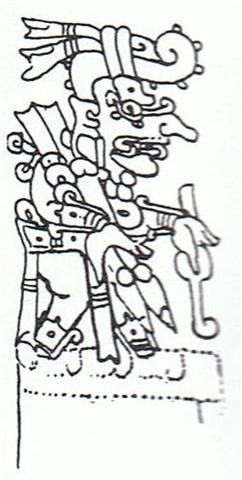

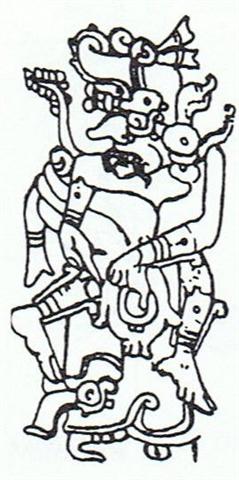
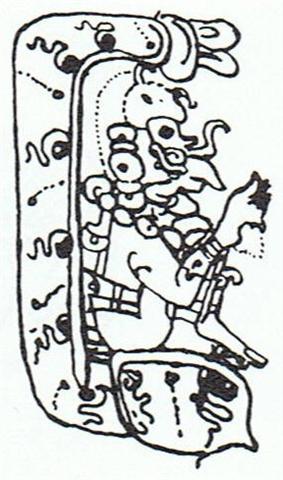
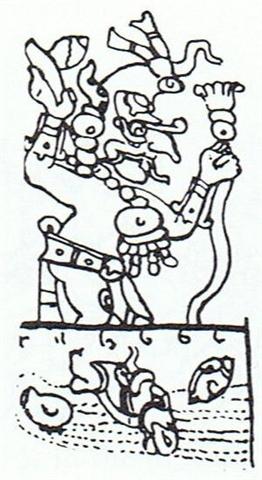

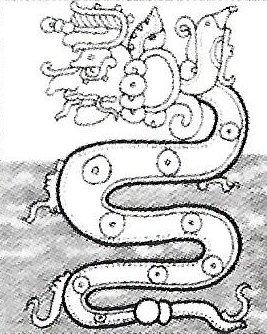
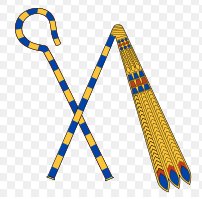 Ψ
Ψ


